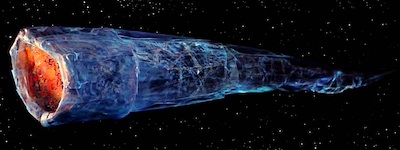
Posted on 05/11/2025 4:04:17 AM PDT by Red Badger

CREDIT: NASA, ESA, STScI, Yuhan Yao (UC Berkeley); Image Processing: Joseph DePasquale (STScI)
**************************************************************
A traveling black hole stalking the cosmos for stellar prey recently revealed itself to NASA telescopes in a tidal disruption event (TDE), shredding and swallowing a star in a radioactive burst.
With its brilliant flash, the TDE AT2024tvd lit up several observatories, including NASA’s Hubble Space Telescope, Chandra X-Ray Observatory, and the NRAO Very Large Array. The TDE event took place 600 million light-years from Earth, allowing astronomers a new glimpse at black hole physics to be published in a future issue of The Astrophysical Journal Letters.
Initially, as the marauding black hole moved through the universe, it was detectable only through gravitational lensing—an effect caused by the black hole’s gravity distorting visible light in a way astronomers could observe.
Eventually, as the black hole encounters a star, its immense gravity pulls the stellar object inward. That intense gravitational force overwhelms the star, spaghettifying it, with some of the remnants forming a bright accretion disc around the black hole’s edge and a stream of electromagnetic radiation pouring out. Shocks and outflows from the accretion disc generate extreme temperatures, producing ultraviolet and visible light emissions.
Out of Center
Black holes are typically found at the centers of their galaxies, but this roaming void in space was the first observed offset from its galaxy, out of the roughly 100 tidal disruption events (TDEs) on record. Intriguingly, the host galaxy already contains a supermassive black hole at its center. The distance between the TDE and the galaxy’s central black hole was only a tenth of the distance from Earth to the Milky Way’s black hole—about 2,600 light-years.
The central black hole in the TDE’s galaxy is larger than the wandering one, and surprisingly, the two have not gravitationally bonded as a binary pair. Yet that could eventually change, with the roaming black hole possibly merging with the larger central black hole in the future.

Above: NASA concept art depicting the stages of a tidal disruption event (Credit: NASA, ESA, STScI, Ralf Crawford (STScI)).
********************************************************************************
“AT2024tvd is the first offset TDE captured by optical sky surveys, and it opens up the entire possibility of uncovering this elusive population of wandering black holes with future sky surveys,” said lead author Yuhan Yao of the University of California at Berkeley. “Right now, theorists haven’t given much attention to offset TDEs. “I think this discovery will motivate scientists to look for more examples of this type of event.”
First Glimpses
The Zwicky Transient Facility, located at Caltech’s Palomar Observatory, was the first to observe the cosmic feeding. Although the TDE shone as brightly as a supernova, astronomers quickly determined it was a different type of event based on its emissions, which revealed hydrogen, helium, carbon, nitrogen, and silicon.
At first, the team suspected the flare was offset from the galactic center. To confirm this, they turned to NASA’s Chandra X-ray Observatory and the Hubble Space Telescope. Chandra’s precise X-ray observations confirmed that the X-ray emissions originated from an offset location. Hubble likewise confirmed the offset with its ultraviolet observation capabilities, clearly detecting the flare’s blue emissions against the backdrop of its galaxy.
Origins and Trajectories
The wandering black hole only becomes visible every tens of thousands of years—each time it consumes a star. Exactly how the black hole became displaced from the center remains a mystery, but astronomers have a few theories. Earlier models suggest that in interactions between three bodies, the smallest black hole can be ejected from the galactic center. This explanation aligns with the black hole’s proximity to the larger central black hole.
“If the black hole went through a triple interaction with two other black holes in the galaxy’s core, it can still remain bound to the galaxy, orbiting around the central region, “said Yao.
Merging galaxies present another possible scenario. If the offset black hole is a remnant from a smaller galaxy that merged into the current one, it could eventually merge with the central black hole. However, astronomers remain uncertain whether the smaller black hole is currently moving closer to or farther from the center.
“There is already good evidence that galaxy mergers enhance TDE rates, but the presence of a second black hole in AT2024tvd’s host galaxy means that at some point in this galaxy’s past, a merger must have happened,” said co-author Erica Hammerstein of UC Berkeley.
============================================================
Ryan Whalen covers science and technology for The Debrief. He holds an MA in History and a Master of Library and Information Science with a certificate in Data Science. He can be contacted at ryan@thedebrief.org, and follow him on Twitter @mdntwvlf.
Wandering Black Hole Ping!................

kind of like Chris Christie or Illinois Gov. JB Pritzker aka Jabba the guv let loose at an all you an eat buffet
The donut hole?
“Runaway Black Hole Devouring a Star 600 Million Light-Years From Earth”
Trump’s fault.
That a black hole employs the ultimate stealth technology if it can approach any star undetected, at least not until it starts ripping apart that star
The should name it Stacy Abrams.

Star prolly went behind a cloud . . .
I hope one doesn’t wander into our neighberhood....lol
Can we put up a sign directing it to hollywood?
I thot black holes were invisible?
Black holes are spotted by the material they’re pulling in.
Disclaimer: Opinions posted on Free Republic are those of the individual posters and do not necessarily represent the opinion of Free Republic or its management. All materials posted herein are protected by copyright law and the exemption for fair use of copyrighted works.